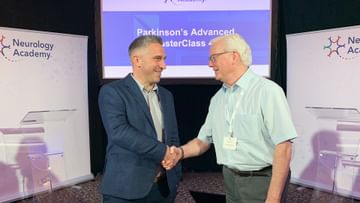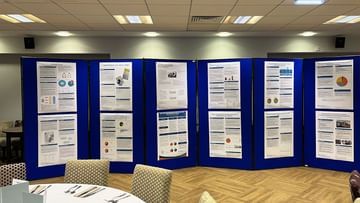Cutting Edge Science – Where are we with deep brain stimulation?
Event reportsIn July this year, the Parkinson’s Academy presented “Cutting Edge Science for Parkinson’s Clinicians”, an educational meeting sponsored by Bial Pharma UK Ltd. This one-day meeting was chaired by Dr Peter Fletcher and attended by a diverse audience of neurologists, care of the elderly physicians, psychiatrists and Parkinson’s nurses. The meeting was a chance to review advances in the clinical understanding of Parkinson’s and discuss how to build on these insights in routine clinical practice. Each week we are posting a blog to look at the day’s speaker sessions in more detail.

In his presentation, Dr Ben Wright (University Hospitals Birmingham NHS Foundation Trust) took the audience through a comprehensive overview of the role of deep brain stimulation (DBS) in Parkinson’s. He discussed how the role of electrical stimulation and location targeting in the treatment of Parkinson’s has long been considered (since the early 1900s!), but that research into functional neurosurgery in Parkinson’s sharply declined with the introduction of levodopa. It was not until the pioneering work of Professor Benabid in Grenoble in 1987, who introduced high frequency DBS of the thalamus, that functional neurosurgery was again considered as a viable option for Parkinson’s. Today, the main target for Parkinson’s is the subthalamic nucleus, and the main target for tremor is the thalamus.Dr Wright shared cases highlighting the often life-changing benefits that DBS can offer patients, but stressed that these benefits are only achieved in the ‘right’ patients. According to the updated NICE guidelines, DBS can be considered for people with advanced Parkinson's whose symptoms are not adequately controlled by best medical therapy.1 However, even after decades of use, there remains a need for a better understanding of who to refer, when to refer them, and what benefits may be achieved, as well as an appreciation of the potential risks. Dr Wright discussed that, while DBS is not a first-line therapy, studies suggest that it may be beneficial to treat earlier versus later, as many studies are conducted in younger patients with a disease duration of about 10 to 13 years.
Which patients are most likely to benefit from DBS?
| Patients more likely to benefit | Patients less likely to benefit |
|---|---|
| Levodopa responsive symptoms | Levodopa unresponsive symptoms |
| Dyskinesia | Dementia |
| ON–OFF fluctuations | Uncontrolled psychiatric disease |
| Tremor | No caregiver |
| Operative risk |
Looking to the future, Dr Wright discussed that the technology for DBS is ever evolving, moving from a single voltage-driven electrical source to multiple-source current steering. New DBS systems now have multiple contacts which once inserted can be used to ‘steer’ the current based on improved imaging and local field recording – even if the electrode is not optimally placed. Another technique in development is ‘adaptive DBS’ which uses feedback about the state of neural circuits to control stimulation rather than continuously delivering a fixed stimulation.2 Pilot studies have suggested that adaptive DBS may potentially be more effective, efficient and selective than conventional DBS, although more work is required to understand how adaptive stimulation might best be delivered.

Moving onto the controversial topic of neuroregeneration, Professor Roger Barker (University of Cambridge) noted that this field of research is once again attracting investment. Attention had moved away from this approach in the face of famously failed trials,3, 4 but Professor Barker suggested that these trials may have been conducted too early – even before trying to understand the mechanisms of success in smaller studies.5, 6 In the context of neurotrophic factors, the key question is whether growth factors such as GDNF (glial cell line-derived neurotrophic factor) and neuturin can promote dopamine neuron survival in the face of the continuing disease process. It is, however, important to remember that successful dopaminergic regeneration would not be a cure, given the extensive pathology in Parkinson’s. Professor Barker explained that many clinical trials of growth factors have used suboptimal methods to deliver the treatment to the target site of action.7 Another problem may be that these treatments have been used too late. At the advanced stages (where neuroregeneration has been trialled), there may be nothing left to save with neurotrophic factors. It is important to remember that these larger trials have been based on smaller pioneering work which has shown that some patients have enjoyed a sustained clinical response to this treatment which correlates with evidence of increased striatal dopaminergic activity.7 The challenge, therefore, is not whether this approach works, because it does in some patients, but rather how we can replicate this more consistently.

Likewise, Professor Barker argued that studies of potential stem cell therapies rushed ahead based on small studies, but without full consideration of the methodologies that the small proof of concept studies showed do work – but not in all patients. While in some patients the effects were long-lasting (>10 years) and life changing,8 the clinical response varied from patient to patient. Thinking about which cells to use, Professor Barker noted that people have been interested in induced pluripotent stem (iPS) cells over embryonic stem cells for some time because this approach avoids some of the ethical issues associated with using embryonic tissue. While, there may not be much difference between them, autologous iPS cell therapy would have the advantage of coming from the patient, but they are considerably more expensive, and there is a concern that the Parkinson’s patient’s cells may already have a predisposition to developing the disease and therefore could, more quickly, succumb to the disease process.9 Of course, stem cell therapies will have to compete with easier, more conventional therapies, but, Professor Barker argued, unlike other treatments in development, stem cell therapies have the potential to radically change the natural history of Parkinson’s.
References:
- NICE. Parkinson’s disease in adults. Available at: nice.org.uk/guidance/ng71. 2017.
- Tinkhauser G, Pogosyan A, Little S, et al. The modulatory effect of adaptive deep brain stimulation on beta bursts in Parkinson's disease. Brain 2017;140(4):1053-1067.
- Olanow CW, Goetz CG, Kordower JH, et al. A double-blind controlled trial of bilateral fetal nigral transplantation in Parkinson's disease. Ann Neurol 2003;54(3):403-414.
- Warren Olanow C, Bartus RT, Baumann TL, et al. Gene delivery of neurturin to putamen and substantia nigra in Parkinson disease: A double-blind, randomized, controlled trial. Ann Neurol 2015;78(2):248-257.
- Freed CR, Greene PE, Breeze RE, et al. Transplantation of embryonic dopamine neurons for severe Parkinson's disease. N Engl J Med 2001;344(10):710-719.
- Barker RA, Barrett J, Mason SL, Bjorklund A. Fetal dopaminergic transplantation trials and the future of neural grafting in Parkinson's disease. Lancet Neurol 2013;12(1):84-91.
- Patel NK, Gill SS. GDNF delivery for Parkinson's disease. Acta Neurochir Suppl 2007;97(Pt 2):135-154.
- Kefalopoulou Z, Politis M, Piccini P, et al. Long-term clinical outcome of fetal cell transplantation for Parkinson disease: two case reports. JAMA Neurol 2014;71(1):83-87.
- Barker RA. Developing stem cell therapies for Parkinson's disease: waiting until the time is right. Cell Stem Cell 2014;15(5):539-542.
Related articles
'The things you can't get from the books'
Parkinson's Academy, our original and longest running Academy, houses 22 years of inspirational projects, resources, and evidence for improving outcomes for people with Parkinson's. Led by co-founder and educational director Dr Peter Fletcher, the Academy has a truly collegiate feel and prides itself on delivering 'the things you can't get from books' - a practical learning model which inspires all Neurology Academy courses.


